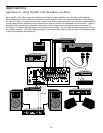
21
Using Equalization
One of the most exciting aspects of using a mixer such as the MPL 1204 is the
ability to shape a sound, using a process called equalization. But there are few
areas of sound engineering more misunderstood than equalization, and, just as
good EQ can really help a sound, bad EQ can really hurt it, so read on...
Every naturally occurring sound consists of a broad range of pitches, or
frequencies, combined together in a unique way. This blend is what gives every
sound its distinctive tonal color. The EQ section in a mixer allows you to alter a
sound by boosting or attenuating specific frequency areas. The MPL 1204
provides independent three-band equalization controls for each of its channels
(the same equalization is applied to both the odd-numbered [left] input and the
even-numbered [right] input). Each EQ knob is labeled with the maximum
amount of cut or boost provided (± 15 dB in the case of Low and High
frequencies, and ±12 dB in the case of the Mid frequency). The Mid frequency
control utilizes a resonant (“bell”) peaking curve, while the Low and High
frequency controls utilize
shelving curves. This means that, in the case of the
Mid EQ control, frequencies around 1 kHz are affected; in the case of the Low
EQ control, frequencies around or below 100 Hz are affected; and, in the case of
the High EQ control, frequencies around or above 10 kHz are affected. We
provided these particular frequency areas because they have maximum impact
on musical signals—that’s why they are sometimes known as “sweet spots.”
When an EQ knob is in its center detented position (“0”), it is having no effect.
When it is moved right of center, the selected frequency area is being boosted;
when it is moved left of center, the frequency area is being attenuated.
In most instances, the best way to approach equalization is to think in terms of
which frequency areas you need to attenuate, as opposed to which ones you
need to boost (boosting a frequency area also has the effect of boosting the
overall signal; too much EQ boost can actually cause overload). Be aware of the
phenomenon of
masking, where loud sounds in one frequency range obscure
softer sounds in the same range; by cutting EQ “notches” in a loud signal, you
can actually make room for a softer one to shine through. And try not to think of
EQ as a miracle worker—no amount of equalization can put a singer in tune or
remove the distortion from an overloaded input signal! The key is to get the
signal right in the first place, by using correct gain structure and mic placement.
Although the specific EQ you will apply to a signal is very much a matter of
personal taste, here are a few general suggestions: Boosting the low frequency
of instruments such as bass drums or bass guitar will add warmth and make the
sound “fatter”; conversely, you may want to attenuate the low frequency
component of instruments such as cymbals, high-hats, and shakers so as to
“thin” them out. Boosting Mid frequencies can be used to help bring out vocals
or guitars, while attenuating them can help to reduce “boxiness.” Be careful not
to boost high frequencies too much or you risk adding hiss to the signal, though
just a touch can help add “shimmer” to an acoustic guitar, ride cymbal, or
high-hat. Finally, because the MPL 1204 High and Low EQ utilize shelving
curves, attenuated High settings can be used to reduce hiss (which is
composed almost exclusively of high frequencies) or attenuated Low frequencies
can be used to reduce rumble (which is composed almost exclusively of low
frequencies).
+15
0
-15
HIGH
+12
0
-12
MID
+15
0
-15
LOW


















